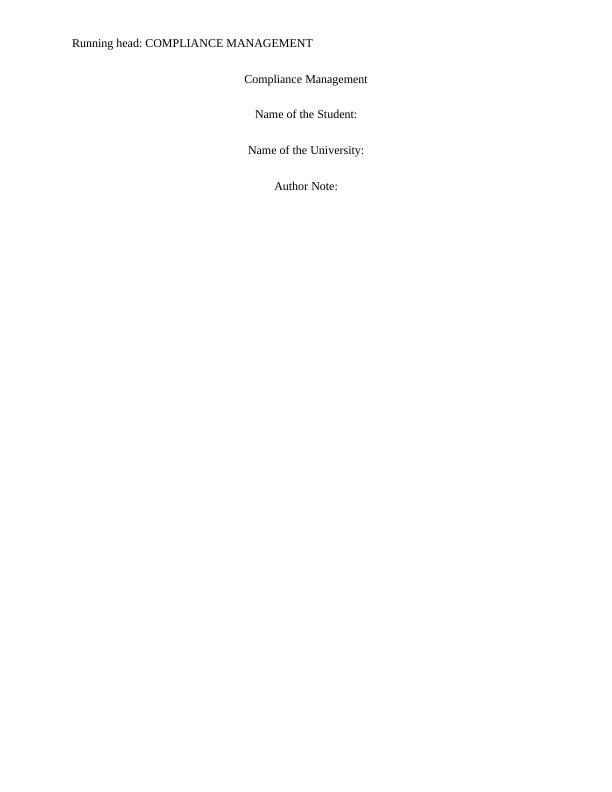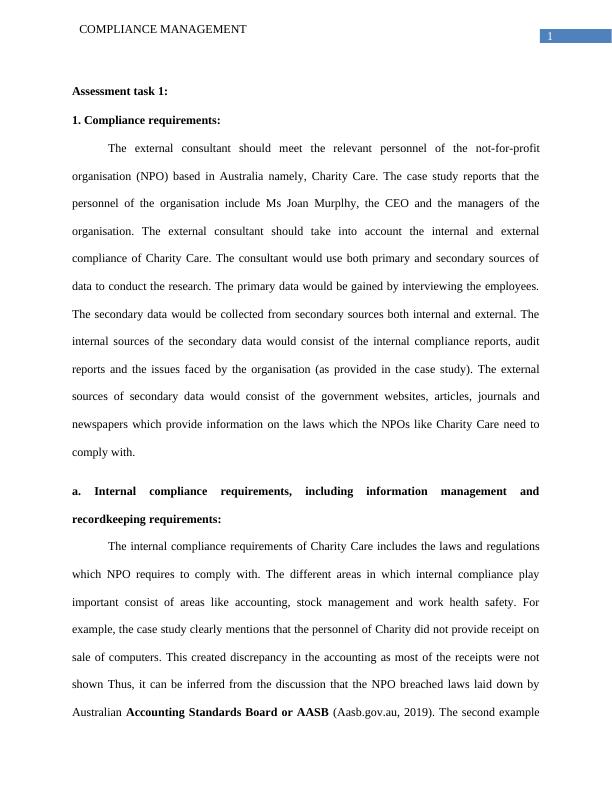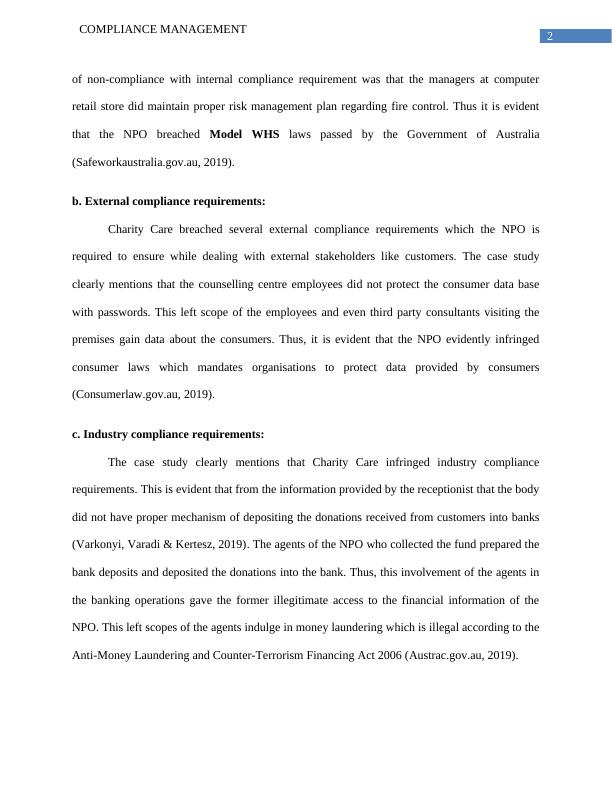Compliance Management for Charity Care
17 Pages3767 Words21 Views
Added on 2023-01-23
About This Document
This document provides an overview of compliance management for Charity Care, a not-for-profit organization in Australia. It covers compliance requirements, internal and external compliance, industry compliance, compliance effects, compliance management systems, personnel requirements, training options, and processes for managing compliance breaches.
Compliance Management for Charity Care
Added on 2023-01-23
ShareRelated Documents
Running head: COMPLIANCE MANAGEMENT
Compliance Management
Name of the Student:
Name of the University:
Author Note:
Compliance Management
Name of the Student:
Name of the University:
Author Note:

1
COMPLIANCE MANAGEMENT
Assessment task 1:
1. Compliance requirements:
The external consultant should meet the relevant personnel of the not-for-profit
organisation (NPO) based in Australia namely, Charity Care. The case study reports that the
personnel of the organisation include Ms Joan Murplhy, the CEO and the managers of the
organisation. The external consultant should take into account the internal and external
compliance of Charity Care. The consultant would use both primary and secondary sources of
data to conduct the research. The primary data would be gained by interviewing the employees.
The secondary data would be collected from secondary sources both internal and external. The
internal sources of the secondary data would consist of the internal compliance reports, audit
reports and the issues faced by the organisation (as provided in the case study). The external
sources of secondary data would consist of the government websites, articles, journals and
newspapers which provide information on the laws which the NPOs like Charity Care need to
comply with.
a. Internal compliance requirements, including information management and
recordkeeping requirements:
The internal compliance requirements of Charity Care includes the laws and regulations
which NPO requires to comply with. The different areas in which internal compliance play
important consist of areas like accounting, stock management and work health safety. For
example, the case study clearly mentions that the personnel of Charity did not provide receipt on
sale of computers. This created discrepancy in the accounting as most of the receipts were not
shown Thus, it can be inferred from the discussion that the NPO breached laws laid down by
Australian Accounting Standards Board or AASB (Aasb.gov.au, 2019). The second example
COMPLIANCE MANAGEMENT
Assessment task 1:
1. Compliance requirements:
The external consultant should meet the relevant personnel of the not-for-profit
organisation (NPO) based in Australia namely, Charity Care. The case study reports that the
personnel of the organisation include Ms Joan Murplhy, the CEO and the managers of the
organisation. The external consultant should take into account the internal and external
compliance of Charity Care. The consultant would use both primary and secondary sources of
data to conduct the research. The primary data would be gained by interviewing the employees.
The secondary data would be collected from secondary sources both internal and external. The
internal sources of the secondary data would consist of the internal compliance reports, audit
reports and the issues faced by the organisation (as provided in the case study). The external
sources of secondary data would consist of the government websites, articles, journals and
newspapers which provide information on the laws which the NPOs like Charity Care need to
comply with.
a. Internal compliance requirements, including information management and
recordkeeping requirements:
The internal compliance requirements of Charity Care includes the laws and regulations
which NPO requires to comply with. The different areas in which internal compliance play
important consist of areas like accounting, stock management and work health safety. For
example, the case study clearly mentions that the personnel of Charity did not provide receipt on
sale of computers. This created discrepancy in the accounting as most of the receipts were not
shown Thus, it can be inferred from the discussion that the NPO breached laws laid down by
Australian Accounting Standards Board or AASB (Aasb.gov.au, 2019). The second example

2
COMPLIANCE MANAGEMENT
of non-compliance with internal compliance requirement was that the managers at computer
retail store did maintain proper risk management plan regarding fire control. Thus it is evident
that the NPO breached Model WHS laws passed by the Government of Australia
(Safeworkaustralia.gov.au, 2019).
b. External compliance requirements:
Charity Care breached several external compliance requirements which the NPO is
required to ensure while dealing with external stakeholders like customers. The case study
clearly mentions that the counselling centre employees did not protect the consumer data base
with passwords. This left scope of the employees and even third party consultants visiting the
premises gain data about the consumers. Thus, it is evident that the NPO evidently infringed
consumer laws which mandates organisations to protect data provided by consumers
(Consumerlaw.gov.au, 2019).
c. Industry compliance requirements:
The case study clearly mentions that Charity Care infringed industry compliance
requirements. This is evident that from the information provided by the receptionist that the body
did not have proper mechanism of depositing the donations received from customers into banks
(Varkonyi, Varadi & Kertesz, 2019). The agents of the NPO who collected the fund prepared the
bank deposits and deposited the donations into the bank. Thus, this involvement of the agents in
the banking operations gave the former illegitimate access to the financial information of the
NPO. This left scopes of the agents indulge in money laundering which is illegal according to the
Anti-Money Laundering and Counter-Terrorism Financing Act 2006 (Austrac.gov.au, 2019).
COMPLIANCE MANAGEMENT
of non-compliance with internal compliance requirement was that the managers at computer
retail store did maintain proper risk management plan regarding fire control. Thus it is evident
that the NPO breached Model WHS laws passed by the Government of Australia
(Safeworkaustralia.gov.au, 2019).
b. External compliance requirements:
Charity Care breached several external compliance requirements which the NPO is
required to ensure while dealing with external stakeholders like customers. The case study
clearly mentions that the counselling centre employees did not protect the consumer data base
with passwords. This left scope of the employees and even third party consultants visiting the
premises gain data about the consumers. Thus, it is evident that the NPO evidently infringed
consumer laws which mandates organisations to protect data provided by consumers
(Consumerlaw.gov.au, 2019).
c. Industry compliance requirements:
The case study clearly mentions that Charity Care infringed industry compliance
requirements. This is evident that from the information provided by the receptionist that the body
did not have proper mechanism of depositing the donations received from customers into banks
(Varkonyi, Varadi & Kertesz, 2019). The agents of the NPO who collected the fund prepared the
bank deposits and deposited the donations into the bank. Thus, this involvement of the agents in
the banking operations gave the former illegitimate access to the financial information of the
NPO. This left scopes of the agents indulge in money laundering which is illegal according to the
Anti-Money Laundering and Counter-Terrorism Financing Act 2006 (Austrac.gov.au, 2019).

3
COMPLIANCE MANAGEMENT
1. Compliance effects:
a. Areas affected:
The infringement of the laws which Charity Care committed affected several areas of
operations of the NPO. For example, not maintaining proper accounting procedures according
toe AASB affected the financial accounting of the company which in turn affected the financial
planning of the body. Secondly, non-compliance of the model WHS laws affected the employees
of Charity Care. This is because lack of proper risk management facilities exposed the
employees to higher WHS risks (Iwu et al., 2015).
b. Risks:
It is evident from the above discussion that the failiure of Charity Care to comply with
the laws attracted several risks. For example, the poor maintenance of the customer data without
passwords left scopes for employee’s customer data for their own interests which led to losing of
customer leads. Thus, the body was not able to approach customers for donations which
escalated into revenue risks (Bradford et al., 2018). Secondly, inappropriate accounting
procedures which Charity Care followed resulted in breach of laws set by AASB, thus resulting
into legal risks like government probes. Thirdly, non-compliance with WHS laws left scope for
employees meeting more accidents resulting in injury and even death of employees.
c. Penalties:
Failure of Charity Care to comply with the risks would attract several penalties. For
example, failure to comply with the accounting laws would attract penalties from the side of
AASB while failure to comply with the WHS laws would attract penalisation by the Fairwork
Ombudsmen (Sepper, 2016).
COMPLIANCE MANAGEMENT
1. Compliance effects:
a. Areas affected:
The infringement of the laws which Charity Care committed affected several areas of
operations of the NPO. For example, not maintaining proper accounting procedures according
toe AASB affected the financial accounting of the company which in turn affected the financial
planning of the body. Secondly, non-compliance of the model WHS laws affected the employees
of Charity Care. This is because lack of proper risk management facilities exposed the
employees to higher WHS risks (Iwu et al., 2015).
b. Risks:
It is evident from the above discussion that the failiure of Charity Care to comply with
the laws attracted several risks. For example, the poor maintenance of the customer data without
passwords left scopes for employee’s customer data for their own interests which led to losing of
customer leads. Thus, the body was not able to approach customers for donations which
escalated into revenue risks (Bradford et al., 2018). Secondly, inappropriate accounting
procedures which Charity Care followed resulted in breach of laws set by AASB, thus resulting
into legal risks like government probes. Thirdly, non-compliance with WHS laws left scope for
employees meeting more accidents resulting in injury and even death of employees.
c. Penalties:
Failure of Charity Care to comply with the risks would attract several penalties. For
example, failure to comply with the accounting laws would attract penalties from the side of
AASB while failure to comply with the WHS laws would attract penalisation by the Fairwork
Ombudsmen (Sepper, 2016).

End of preview
Want to access all the pages? Upload your documents or become a member.
